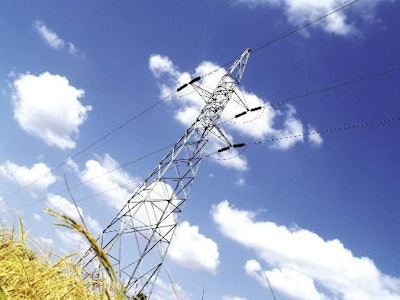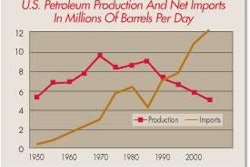
Many broiler growers on the Delmarva Peninsula got troubling news when they opened their electric bills last summer; their electric rates had gone way up. Growers' rate increases varied, depending on the utility providing power and the state where the farm was located. Some electric cooperative customers experienced rate increases of 10 percent or less, but customers of Delmarva Power, a publicly-owned utility company, had rate increases of from 40 percent to 64 percent, depending on the rate class the farm fell under. Large commercial users had even higher rate increases.
Tunnel-ventilated chicken houses use a lot of kilowatt hours in the summertime, so growers went to their integrators and their local trade association for help.
Delmarva Poultry Industry, Inc., (DPI) is a poultry industry trade association for Delaware, the Eastern Shore of Maryland and the Eastern Shore of Virginia. Bill Satterfield, executive director, DPI, said that the organization first looked into forming a buying group for growers on Delmarva when deregulation of electricity first occurred just over five years ago. At that time, forming a buying group didn't have any real payback, because a five-year rate freeze was in place on "retail" electric rates on Delmarva, and there were no companies interested in working with the chicken industry. The rate freeze expired in July of 2005 for some Maryland customers and in May of 2006 for Delaware customers, and utilities adjusted rates depending on contracts for purchasing wholesale electricity and/or their own generating costs.
Much of the electricity used on Delmarva is imported from other areas. Deregulation was on the purchase of the electric generation supply, and it was intended to work in the same way that deregulation of long-distance phone service has worked. Your local phone company still maintains the poles and wires in your area, but a number of companies can compete for your long-distance service. In response to deregulation of electricity, some utilities sold electric power generating plants and began purchasing power from the wholesale market by contract rather than generating it. With the end of the Delmarva rate freeze, several third-party electricity suppliers became licensed to do business on Delmarva and were looking for customers.
Cooperative buying and/or selling groups have a long history in agriculture. In many parts of the country farmers have formed cooperatives to use the collective size of their operations to obtain better prices for everything from grain to chickens. An electricity buying group can work in the same way.
"DPI formed an energy advisory group made up of people working for the poultry companies who had been involved in buying electricity for their companies to steer us in the right direction," Satterfield said. "They identified all of the electric suppliers who were potential vendors and also identified all of the consulting groups who could help pull together the information on the electric usage of the DPI members who wanted to join the buying pool and aggregate it to show the electricity providers what they would be bidding on," he said.
From a number of consulting groups that expressed interest in helping DPI form an electricity buying group, DPI chose Ed Jackson's Affinity Energy Management, LLC, to help broker a deal to buy power. Jackson and DPI held public meetings with DPI members and other interested individuals to explain the process of forming the buying group and soliciting bids, late last fall. After gathering usage and rate information from the growers, businesses and individuals who were interested in joining the buying group and contacting third-party electricity suppliers, it became clear that a buying group would only make sense for a portion of DPI's members.
Members who did not have a business or poultry houses on their electric meters did not use enough electricity to help the buying pool. These small residential users of electricity were put into a separate program offered by Washington Gas Energy Services (WGES), and they still get a better rate than from Delmarva Power. DPI members with at least one poultry house or business customers of Delmarva Power in Maryland and Delaware would be able to get lower rates by joining the buying group. Members who are serviced by the other cooperative utilities on the shore or who live in Virginia were better off staying with their current providers.
Members of the buying pool paid a $25 application fee to Affinity Energy Management to handle all of the initial paperwork required to form the pool. The contact period was for six months, from January 2007 until June 2007. WGES was the winning bidder with a bid of $0.0865 per kilowatt-hour. Over 200 DPI members signed contracts with WGES within a 48-hour period and are now part of the buying pool. It is estimated that they will save close to $200,000 over the six-month contract period.
Individual DPI members in the buying pool, depending upon which state they are in, their electric tariff rate class, and the volume of energy used, will save, on average, about 15 percent off the generation portion of their electric bill. A grower with three chicken houses is projected to save between $500 and $675 over the term of the contract. Actual savings will depend upon many factors, including the state where they live, their tariff rate class, chicken house size, equipment used, ages of the birds raised, weather conditions and weather-tightness of the houses.
"With rising electricity costs, especially for our poultry growers due to recent higher rates and increased consumption, these savings will help growers maintain their farming operations," said Roger Marino, DPI president.
DPI intends to explore creation of a subsequent one-year electric buying group this spring to cover the June 2007-June 2008 period. This effort will depend upon Delmarva Power's standard offer supply rates that are scheduled to change starting in June 2007.
"If DPI believes it can help its members with additional electric savings in the 12 months following expiration of the original buying group, then we will move ahead through retaining present members in the program and recruiting additional individuals, including poultry growers and businesses that currently are not DPI members," said Jackson.
Jackson commented on the potential of electricity buying groups for growers in other parts of the USA. "It is very state specific whether or not there are opportunities for cost savings from buying electricity from a third party," said Jackson. States like California, Illinois, New York and Western Pennsylvania offer opportunities for savings from third-party power providers. Texas is usually used as the example of success for deregulation, according to Jackson. Around a third of residential customers in Texas are now buying from third-party providers. Jackson said that in most states, unless the residential rates are exceedingly high, less than 10 percent of residential customers are switching to third-party providers.
Growers should check their electric bill and/or contact their utility company to see if they have a choice of electric providers, Jackson suggested. He said that another source of information is a state's regulatory commission for utilities. Some states did not deregulate, because the utilities in those states already have relatively low electric rates or because of some of the fallout from the Enron scandal. For instance, Virginia is currently pursuing re-regulating its electric industry.
If you are in a state with a competitive market for electricity, meaning you can buy power for less than the utilities tariff rate, then a group as small as 50 growers could be big enough to attract interest from power suppliers, according to Jackson. However, Jackson explained that some power suppliers are not interested in serving residential customers at all; even large farms that are on "residential" service are not of interest to them.
Traditionally residential rates are higher than commercial rates. It varies case by case and utility by utility, but growers should contact their utility and ask what rate programs are available. Utility companies have an obligation to help you find the best rate for your circumstance, but you have to ask. Jackson said that some utilities have special residential rates for agricultural customers, so a commercial rate might not be better than this type of rate. A farm's specific usage profile is required to analyze which rate is best. Finally, Jackson said that growers need to understand the rate that their farm is currently receiving, know if and when it is scheduled to change, and know what the options are from your present utility company before signing up for a buying group.


.jpg?auto=format%2Ccompress&fit=crop&h=167&q=70&w=250)














